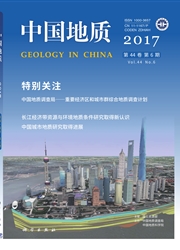

 中文摘要:
中文摘要:
本文系统解析并分析了1931年8月-2005年10月期间青藏高原及其周围发生的905个震级M4.5-8.5地震的震源机制结果,研究了青藏高原岩石圈的区域应力场与构造运动特征。结果表明,来自印度板块的北北东或北东方向的水平挤压应力控制了青藏高原及其周缘地区的岩石圈应力场。从喜马拉雅到贝加尔湖以南包括中国西部的广大范围内,主压应力P轴的水平分量位于近NE-SW方向,形成了一个广域的NE—SW方向的挤压应力场。特别是青藏高原周缘地区,除其东部边缘外,南部的喜马拉雅山前沿以及青藏高原的北部、西部边缘地区所发生的绝大部分地震都属于逆断层型或走滑逆断层型地震,表现出周缘地区的水平挤压应力更为强势。应力场特征充分表明,印度板块的北上运动,以及它与欧亚板块之间的碰撞,所形成的挤压应力场是青藏高原强烈隆起的直接原因。在青藏高原周缘地区受到强烈挤压应力场控制的同时,有大量正断层型地震集中发生在青藏高原中部海拔4000m以上的地区,其中许多地震是纯正断层型地震。震源机制结果显示,近E-W向或WNW—ESE向的水平扩张应力控制着该区的岩石圈应力场;正断层型地震的断层走向多为南北方向,断层位错矢量的水平分量大体位于近东西方向。这表明青藏高原中部高海拔地区存在着近东西方向的扩张构造运动,且扩张构造运动是该区引张应力场的作用结果。其动力学原因可能与持续隆升的高原自重增大引起的重力崩塌及其周边区域构造应力状况有关。研究青藏高原存在挤压应力场与引张应力场及其构造运动的区域特征,对于认识青藏高原形成、发展的地球动力学机制,有着极其雷要的意义。
 英文摘要:
英文摘要:
The authors systematically analyzed the focal mechanism solutions of 905 earthquakes (M4.6-8.5) that occurred in and around the Qinghai-Tibet PLateau between 1931 and 2005 and studied the characteristics of the regional stress field and tectonic movement of the lithosphere below the Qinghai-Tibet Plateau. The results show that the NNE or NE horizontal compressional stress due to the northward movement of the Indian plate predominates the tectonic stress fields in and around the study region. The horizontal components of the principal compressional stress P axes are oriented in a nearly NE-SW direction, forming a wide NE-SW compressional stress field in a wide areal extent from the Himalayas to south of Baikal Lake, including western China. Especially in the surrounding areas of the Qinghai-Tibet PLateau, earthquakes caused by reverse and strike-slip faulting are predominant in the Himalayan Mountain front on the southern Qinghai-Tibet Plateau and on the northern and western margins of the plateau, except the eastern margin. It implies that a strong horizontal compressional stress exists around the plateau. The characteristics of the stress field show that the direct cause of the uplift of the Qinghai-Tibet Plateau is due to the compressional stress field formed by the northward movement of the Indian plate and India-Eurasia collision. Many normal fault type earthquakes are concentrated in areas with elevations of 〉4000 m above sea level on the central Qinghai-Tibet Plateau while the surrounding areas of the Qinghai-Tibet Plateau are subjected to the control of the strong compressional stress field. Of these, many earthquakes are pure normal fault type ones. Their focal mechanism solutions show that the nearly E-W or WNW-ESE horizontal tensional stress controls the lithospheric stress field in the region. The normal fault type earthquake faults mostly strike N-S and the horizontal component of the displacement vectors of the faults is largely oriented in a nearly E-W direction. This indicates that a nearly E
 同期刊论文项目
同期刊论文项目
 同项目期刊论文
同项目期刊论文
 期刊信息
期刊信息
